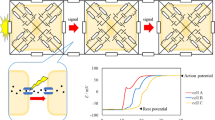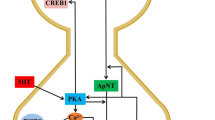Abstract
The release of vesicular glutamate, spatiotemporal changes in glutamate concentration in the synaptic cleft and the subsequent generation of fast excitatory postsynaptic currents at a hippocampal synapse were modeled using the Monte Carlo method. It is assumed that glutamate is released from a spherical vesicle through a cylindrical fusion pore into the synaptic cleft and that S-α-amino-3-hydroxy -5-methyl-4-isoxazolepropionic acid (AMPA) receptors are uniformly distributed postsynaptically. The time course of change in vesicular concentration can be described by a single exponential, but a slow tail is also observed though only following the release of most of the glutamate. The time constant of decay increases with vesicular size and a lower diffusion constant, and is independent of the initial concentration, becoming markedly shorter for wider fusion pores. The cleft concentration at the fusion pore mouth is not negligible compared to vesicular concentration, especially for wider fusion pores. Lateral equilibration of glutamate is rapid, and within ≈50 µs all AMPA receptors on average see the same concentration of glutamate. Nevertheless the single-channel current and the number of channels estimated from mean-variance plots are unreliable and different when estimated from rise- and decay-current segments. Greater saturation of AMPA receptor channels provides higher but not more accurate estimates. Two factors contribute to the variability of postsynaptic currents and render the mean-variance nonstationary analysis unreliable, even when all receptors see on average the same glutamate concentration. Firstly, the variability of the instantaneous cleft concentration of glutamate, unlike the mean concentration, first rapidly decreases before slowly increasing; the variability is greater for fewer molecules in the cleft and is spatially nonuniform. Secondly, the efficacy with which glutamate produces a response changes with time. Understanding the factors that determine the time course of vesicular content release as well as the spatiotemporal changes of glutamate concentration in the cleft is crucial for understanding the mechanism that generates postsynaptic currents.
Similar content being viewed by others
Author information
Authors and Affiliations
Additional information
Received: 28 May 1998 / Received after revision: 17 August 1998 / Accepted: 3 September 1998
Rights and permissions
About this article
Cite this article
Glavinović, M. Monte Carlo simulation of vesicular release, spatiotemporal distribution of glutamate in synaptic cleft and generation of postsynaptic currents. Pflügers Arch 437, 462–470 (1999). https://doi.org/10.1007/s004240050802
Issue Date:
DOI: https://doi.org/10.1007/s004240050802




